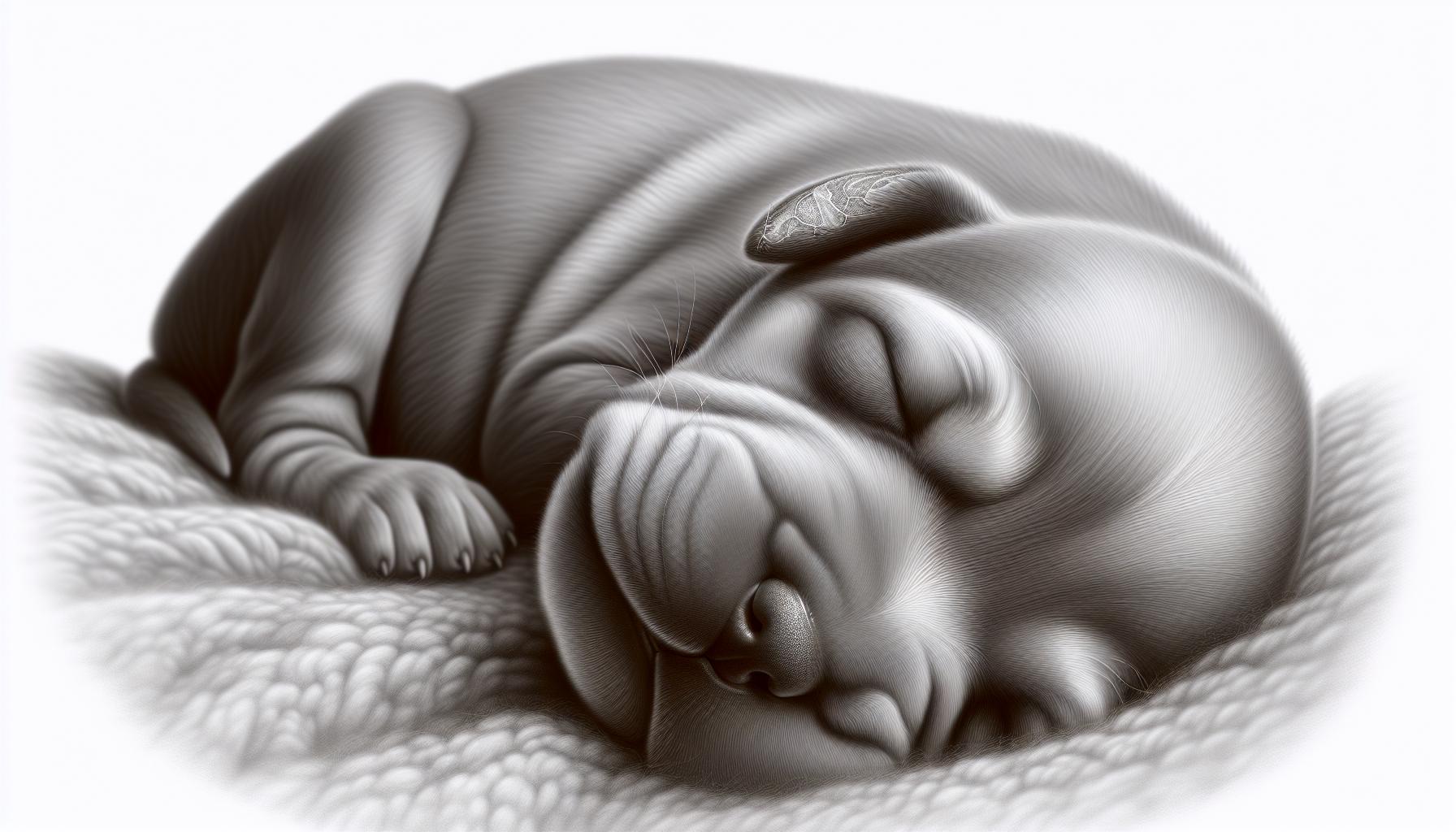When puppies first enter the world, they can’t hear a single sound. Like many other mammals, newborn puppies are deaf and blind, making their early days utterly dependent on their mother’s care and guidance.
This temporary deafness is a natural part of puppy development as their ear canals remain closed for the first few weeks of life. Their auditory system gradually develops during this crucial period, preparing them for a world of sounds. Hearing development typically begins around two weeks of age when their ear canals open, and they become more responsive to the world around them.
Understanding Puppy Hearing Development
Puppy hearing development follows a precise timeline from birth through the first few weeks of life. The auditory system matures gradually as the ear canals open during early development.
When Puppies Start to Hear
Puppy ear canals open 10 to 14 days after birth, beginning their auditory development. Their hearing becomes fully functional at 3 weeks old, developing into a more sophisticated system than human hearing. At this stage, puppies detect sounds beyond the human auditory range, enabling them to respond to high-frequency noises their owners can’t hear.
The Natural Birth State of Puppies
Puppies enter the world with closed eyes and sealed ear canals, leaving them temporarily deaf and blind. Their eyes remain closed for 14 to 21 days after birth, while their sense of smell operates entirely from day one. This heightened olfactory sense compensates for their limited hearing and vision, helping them locate their mother and navigate their environment during the first weeks of life.
| Puppy Development Milestone | Timeline |
|---|---|
| Birth State | Deaf and blind |
| Ear Canal Opening | 10-14 days |
| Full Hearing Development | 21 days |
| Eye Opening | 14-21 days |
| Sense of Smell | Functional from birth |
The Science Behind Puppy Hearing

Puppy hearing development involves complex anatomical changes during the first weeks of life. Their auditory system matures through distinct developmental stages, starting from complete deafness at birth.
Ear Canal Development
Newborn puppies have sealed ear canals that prevent sound transmission to the inner ear structures. The ear canals remain closed 10-14 days after birth as a protective mechanism for the delicate inner ear components. The ear canal lining undergoes cellular changes during this period, preparing for sound reception.
Formation of Auditory Structures
The auditory structures in puppies develop in a specific sequence:
- Hair cells in the inner ear mature between days 14-16
- Neural connections between the ear and brain strengthen from days 16-20
- Sound-processing regions in the brain activate between days 20-25
- Middle ear muscles develop full functionality by day 21
| Development Stage | Timeline (Days After Birth) |
|---|---|
| Ear Canal Opening | 10-14 |
| Hair Cell Maturation | 14-16 |
| Neural Connection Development | 16-20 |
| Complete Hearing Function | 21-25 |
This developmental sequence reflects an evolutionary adaptation that prioritizes essential survival functions while allowing time for complex sensory systems to mature fully. The gradual formation of these structures ensures optimal hearing capability once the ear canals open.
Signs Your Puppy Is Developing Normal Hearing

Identifying normal hearing development in puppies involves observing specific behavioral responses to sounds. These responses emerge in a predictable pattern as their auditory system matures.
Key Developmental Milestones
- Startles or twitches in response to sudden loud noises at 3 weeks
- Turns head toward familiar sounds such as mother’s voice by week 4
- Responds to their name with ear movement or head-turning at 5-6 weeks
- Shows interest in various sound frequencies, including whistles, claps, or squeaky toys
- Displays increased alertness to environmental sounds like doorbells, footsteps, or car noises
- No response to loud noises by 4 weeks old
- Lack of head-turning toward sound sources by 5 weeks
- Unresponsive to their name by 6 weeks
- Excessive vocalization or unusual crying sounds
- Tilting head consistently to one side
- Walking in circles or showing poor balance
- Different-sized ear canals between right ears
- Limited social interaction with littermates
| Age | Expected Response |
|---|---|
| 3 weeks | Basic startle response |
| 4 weeks | Sound localization |
| 5 weeks | Name recognition |
| 6 weeks | Full sound discrimination |
Testing Your Puppy’s Hearing Abilities

Testing a puppy’s hearing capabilities involves specific observational techniques that monitor their responses to various sound stimuli. These tests become relevant once puppies reach 3 weeks of age when their auditory system begins functioning.
Simple At-Home Hearing Tests
- Sound Response Test: Create sudden noises behind the puppy’s head using hand claps, whistles, or squeaky toys to observe their reaction
- Distance Calling: Stand at varying distances while calling the puppy’s name without visual cues
- Sleep Startle Test: Make unexpected sounds while the puppy sleeps to check for movement responses.
- Directional Hearing: Create sounds from different directions to test the puppy’s ability to locate sound sources
- Environmental Sounds: Monitor reactions to everyday household noises like doorbells, vacuum cleaners, or kitchen timers
- No Response: Contact a vet if the puppy shows no reaction to loud sounds by 4 weeks of age
- Delayed Development: Seek professional evaluation when hearing milestones lag behind littermates
- Breed-Specific Concerns:
- Schedule examinations for breeds with a genetic predisposition to deafness:
- Dalmatians
- Australian Shepherds
- Jack Russell Terriers
- Physical Signs:
- Book an appointment if you notice:
- Head tilting
- Balance issues
- Excessive vocalization
- Behavioral Changes:
- Get veterinary assessment for:
- Unresponsiveness to verbal commands
- Startling easily when touched
- Deep sleeping without reaction to noise
Breeds Prone to Congenital Deafness

Congenital deafness affects specific dog breeds due to genetic factors linked to coat color patterns. Here’s a breakdown of breeds with higher instances of inherited hearing issues:
| Breed | Deafness Rate | Notable Factors |
|---|---|---|
| Dalmatians | 25% one ear, 10% both ears | Higher prevalence in the US vs. Europe |
| English Cocker Spaniels | 1.1% | Genetic predisposition |
| Australian Cattle Dogs | 3% | Associated with Merle coloring |
Common Risk Factors
- Whitecoat genes: Dogs with predominantly white coats carry genes linked to hearing loss
- Piebald patterns: Present in Bull Terriers, increases deafness risk
- Merle coloring: Associated with hearing impairment in multiple breeds
- Genetic inheritance: Passes through breeding lines affecting specific populations
- Dalmatians face the highest risk, with 35% affected by partial or complete deafness
- Bull Terriers show significant rates due to piebald gene presence
- English Setters demonstrate notable instances of hearing impairment
- English Cocker Spaniels maintain a consistent occurrence rate
- Australian Cattle Dogs experience moderate levels of congenital deafness
This genetic predisposition varies in severity across different breeding lines within each affected breed. Early hearing tests identify affected puppies, enabling appropriate care modifications.
Supporting Puppies with Hearing Issues
Early Detection and Accommodation
- Monitor puppy behavior closely during the first 4 weeks for signs of hearing development.
- Create a consistent routine with visual cues for feeding, playtime, and walks.
- Use hand signals alongside verbal commands from the start of training
- Maintain eye contact during interactions to establish communication patterns
- Install bright lights or visual alerts to get the puppy’s attention
Safety Considerations
- Secure the environment by blocking access to potential hazards
- Use vibrating collars designed for deaf puppies to aid in communication
- Install reflective materials or motion-sensor lights in outdoor areas
- Keep deaf puppies on a leash during walks to prevent wandering
- Place bells on other household pets to help the deaf puppy track their movement
Training Techniques
- Focus on positive reinforcement through visual rewards
- Replace auditory markers with hand signals or flashlight signals
- Use gentle physical touch to get attention before giving commands
- Teach basic commands through demonstration with hearing littermates
- Incorporate vibration-based training tools for distance communication
Social Integration
- Introduce the puppy to other dogs in controlled environments
- Use play dates with well-behaved dogs to teach social cues
- Position deaf puppies where they can observe other dogs’ reactions
- Create safe spaces where the puppy can retreat if overwhelmed
- Educate visitors about appropriate ways to approach the deaf puppy
- Consult with veterinary specialists for hearing assessments
- Work with certified trainers experienced in deaf dog training
- Schedule regular checkups to monitor overall development
- Connect with deaf dog support groups for additional resources
- Document training progress to track effective communication methods
Conclusion
Understanding a puppy’s hearing development is crucial for responsible pet ownership. While puppies are born deaf, their hearing typically develops between two and three weeks of age when their ear canals open and mature. This natural process allows time for their complex auditory system to develop fully.
Regular monitoring during these early weeks helps identify potential hearing issues, especially in breeds genetically predisposed to deafness. Whether a puppy develops normal hearing or faces challenges, appropriate care and training can effectively support its growth and development.
Early detection and proper support ensure that puppies with hearing impairments can lead happy, fulfilling lives alongside their hearing counterparts. With the appropriate knowledge and preparation, pet owners can provide the best care for their puppies during this critical developmental stage.



